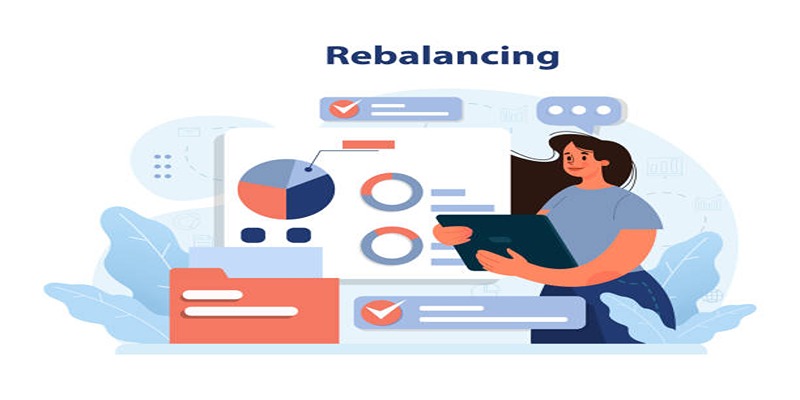Rebalancing Your Portfolio: When and Why It Matters
Advertisement
Portfolio adjustments help you control your investment assets. Portfolios can become unbalanced through time because market changes affect the initial stock, bond and other asset distribution. Changes in vulnerability levels and long-term objectives become affected by this situation. Portfolio rebalancing enables investors to maintain proper portfolio alignment by adjusting their investments according to their initial strategy. It might feel complicated, but understanding when and why to rebalance can make a big difference in keeping your investments aligned with your financial objectives.
What is Portfolio Rebalancing?

A rebalancing process for portfolios involves altering your investment asset distribution to preserve your targeted risk tolerance and expected return level. You need to purchase or sell portfolio assets to restore their original mixture according to your initial investment plan. A portfolio consists of defined proportions of stock, bond, cash and real estate investments.
Why is Rebalancing Important?
There are several reasons why rebalancing is important:
- Manage Risk: Market transformations produce different performance results between assets. Portfolio unbalance occurs when your investments deviate from their intended risk level. Your ability to manage risk remains steady through rebalancing because it helps you maintain the correct mix of assets.
- Maintain Diversification: Diversifying your investments is an essential part of reducing risk in your portfolio. However, as certain assets grow or shrink in value, they can throw off your diversification strategy. Rebalancing ensures that you have a well-diversified portfolio that aligns with your goals.
- Stay on Track with Goals: Rebalancing also helps you stay on track with your long-term financial goals. By adjusting your investments to match your plan, you can maintain a consistent level of risk and potentially increase your chances of reaching those goals in the future.
When Should You Rebalance Your Portfolio?
There are no set rules for when you should rebalance your portfolio, as it depends on your investment strategy and goals. However, there are some general guidelines that can help you determine when is the right time to rebalance:
- Set Time Intervals – Some investors choose to rebalance their portfolio at regular intervals, such as every 6 months or once a year. This keeps things simple and ensures that your portfolio is consistently aligned with your goals.
- Percentage Deviation – An effective strategy for portfolio management is to rebalance when an asset class strays significantly from its target allocation. For instance, if your portfolio is set at 60% stocks and 40% bonds, you might decide to rebalance once the stock allocation rises to 65%.
- Trigger Events – Significant market events or changes in your personal financial situation can also be triggers for rebalancing. For instance, if the stock market experiences a significant downturn, it may be time to reassess and rebalance your portfolio.
Steps to Rebalance Your Portfolio
Rebalancing your portfolio may seem overwhelming, but following these simple steps can make the process easier:
- Review Your Goals and Risk Tolerance: Before making any changes to your portfolio, it's important to review your long-term financial goals and risk tolerance.
- Gather Information on Current Asset Allocation: Determine the current allocation of assets in your portfolio by looking at the percentage of each investment type.
- Compare with Target Allocation: Compare your current asset allocation with your target allocation to identify any differences.
- Decide How to Rebalance: Based on your preferred method (time intervals, percentage deviation, or trigger events), decide which assets need to be bought or sold to get your portfolio back in line with your target allocation.
- Execute Trades: Once you have decided on the changes to be made, execute the trades needed to rebalance your portfolio.
- Monitor and Repeat: After rebalancing, continue to monitor your portfolio regularly and make adjustments as needed. Rebalancing is an ongoing process that should be repeated at regular intervals or when significant changes occur.
Challenges and Mistakes to Avoid
While rebalancing is essential for managing your portfolio, there are some challenges and mistakes to watch out for:
- Transaction Costs: Depending on the investments you hold, rebalancing can result in transaction costs. It's important to consider these costs when making decisions about rebalancing.
- Emotional Decisions: It can be tempting to make emotional decisions during market fluctuations, but it's important to stick to your long-term investment plan and not let emotions drive your rebalancing decisions.
- Market Timing: Trying to time the market by frequently rebalancing may do more harm than good. Instead, focus on maintaining a well-diversified portfolio that aligns with your goals.
Benefits of Regular Rebalancing
Rebalancing may seem like an unnecessary hassle, but there are several benefits to regularly rebalancing your portfolio:
- Maintain Risk Level: By regularly rebalancing, you can ensure that your portfolio maintains a consistent level of risk and stays aligned with your long-term goals.
- Reduce Emotional Investing: Rebalancing based on a predetermined strategy helps reduce the impact of emotions on investment decisions.
- Maximize Returns: Regular rebalancing can potentially increase returns by selling high-performing assets and buying underperforming assets at a lower cost.
Seeking Professional Advice
Managing and rebalancing your portfolio can be complex and time-consuming. If you are unsure about how to rebalance your portfolio, it's best to seek advice from a financial advisor who can help create a personalized plan that aligns with your goals and risk tolerance. A financial professional can also assist in navigating the challenges of rebalancing and provide guidance on making informed investment decisions for long-term success.
Conclusion
Portfolio rebalancing is an important aspect of managing your investments. It helps you stay in control of risk, maintain diversification, and stay on track with your long-term financial goals. By following a disciplined approach and regularly monitoring your portfolio, you can make informed decisions about when and how to rebalance. Remember to consider transaction costs, avoid emotional investing, and focus on the long-term benefits of maintaining a well-balanced portfolio.
Advertisement













